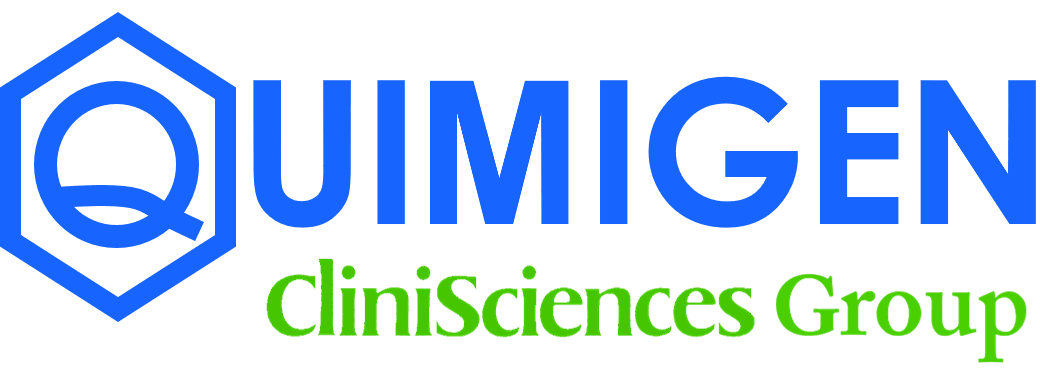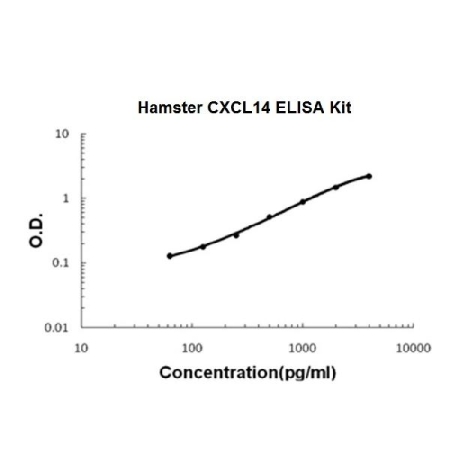CXCL14 ELISA Kit (Hamster)
Cat# OKBB00936
Size : 96wells/kit,withremovablestrips.
Brand : Aviva Systems Biology
| Datasheets/Manuals | Click here to download product manual. As variation between lots may occur, always reference the lot-specific manual received with each kit. |
|---|
| Predicted Species Reactivity | Hamster | ||||||||||||||||||||||||||||||||||||||||||
|---|---|---|---|---|---|---|---|---|---|---|---|---|---|---|---|---|---|---|---|---|---|---|---|---|---|---|---|---|---|---|---|---|---|---|---|---|---|---|---|---|---|---|---|
| Application | ELISA | ||||||||||||||||||||||||||||||||||||||||||
| ELISA Kit Detection Method | Colorimetric, OD450 nm | ||||||||||||||||||||||||||||||||||||||||||
| ELISA Kit Duration | ~ 3 Hours | ||||||||||||||||||||||||||||||||||||||||||
| ELISA Kit Principle | Aviva's Hamster CXCL14 ELISA Kit was based on standard sandwich enzyme-linked immune-sorbent assay technology. A monoclonal antibody from mouse specific for CXCL14 has been precoated onto 96-well plates. Standards(E.coli, S35-E111) and test samples are added to the wells, a biotinylated detection polyclonal antibody from goat specific for CXCL14 is added subsequently and then followed by washing with PBS or TBS buffer. Avidin-Biotin-Peroxidase Complex was added and unbound conjugates were washed away with PBS or TBS buffer. HRP substrate TMB was used to visualize HRP enzymatic reaction. TMB was catalyzed by HRP to produce a blue color product that changed into yellow after adding acidic stop solution. The absorbance of yellow is proportional to the Hamster CXCL14 amount of sample captured in plate. | ||||||||||||||||||||||||||||||||||||||||||
| ELISA Kit Range | 62.5 pg/ml - 4,000 pg/ml | ||||||||||||||||||||||||||||||||||||||||||
| ELISA Kit Reproducibility |
| ||||||||||||||||||||||||||||||||||||||||||
| ELISA Kit Component |
| ||||||||||||||||||||||||||||||||||||||||||
| Additional Information | To assay reproducibility, three samples with differing target protein concentrations were assayed using four different lots.
*number of samples for each test n=16. | ||||||||||||||||||||||||||||||||||||||||||
| :: |
| ||||||||||||||||||||||||||||||||||||||||||
| Reconstitution and Storage | Store at 4C for 6 months, at -20C for 12 months. Avoid multiple freeze-thaw cycles (Shipped with wet ice.) | ||||||||||||||||||||||||||||||||||||||||||
| Sample Type | Sandwich High Sensitivity ELISA kit for Quantitative Detection of Chinese hamster CXCL14 | ||||||||||||||||||||||||||||||||||||||||||
| Sensitivity | <10 pg/ml | ||||||||||||||||||||||||||||||||||||||||||
| Immunogen | Expression system for standard: E.coli; Immunogen sequence: S35-E111 | ||||||||||||||||||||||||||||||||||||||||||
| Gene Symbol | CXCL14 |
|---|---|
| Gene Full Name | C-X-C motif chemokine 14 |
| Alias Symbols | C-X-C motif chemokine 14;Chemokine BRAK;MIP-2G;Small-inducible cytokine B14;CXCL14;MIP2G, NJAC, SCYB14;PSEC0212, UNQ240/PRO273; |
| NCBI Gene Id | 100754406 |
| Protein Name | C-X-C motif chemokine 14 |
| Description of Target | Chemokine(C-X-C motif) ligand 14(CXCL14) is a small cytokine belonging to the CXC chemokine family that is also known as BRAK(for breast and kidney-expressed chemokine). This gene is mapped to 5q31.1. CXCL14 is constitutively expressed at high levels in many normal tissues, it has been found that fibroblasts are the primary source of CXCL14 and that CXCL14 is involved in the homeostasis of monocyte-derived macrophages rather than in inflammation. It is also a potent chemoattractant and activator of dendritic cells, is implicated in homing of these cells, and can stimulate the migration of activated NK cells. CXCL14 also inhibits angiogenesis, possibly as a result of its ability to block endothelial cell chemotaxis. In addition to it, CXCL14 is a potent chemokine for immature DCs, with a chemoattractive activity comparable to bacterial fMLP and MIP1A. |
| Uniprot ID | O95715 |
| Protein Accession # | NP_004878.2 |
| Nucleotide Accession # | NM_004887.4 |




